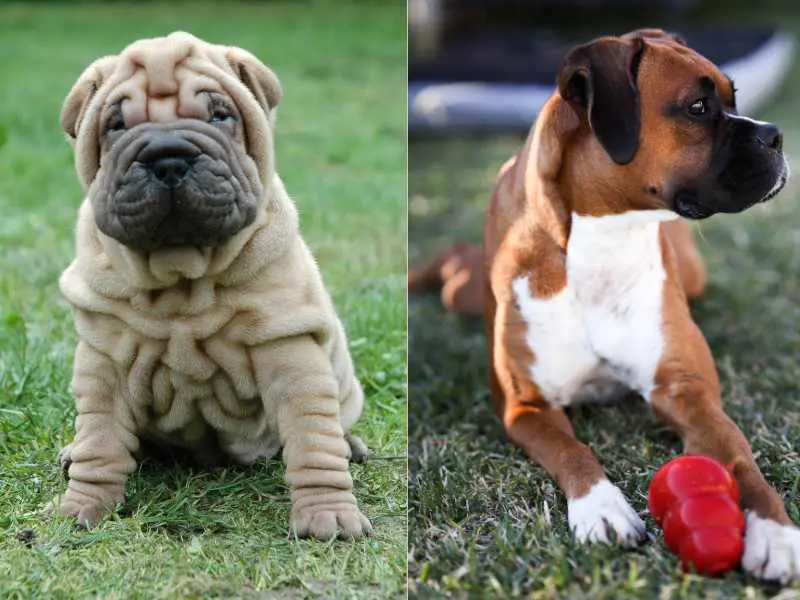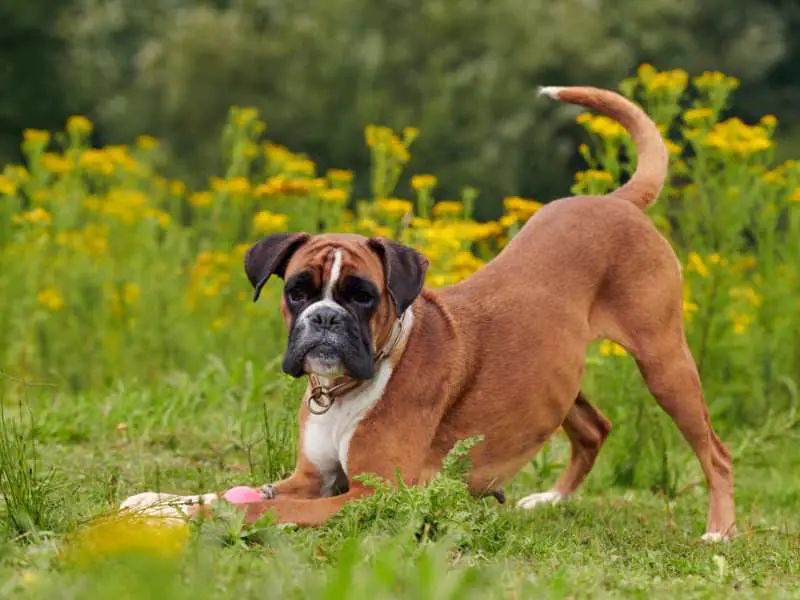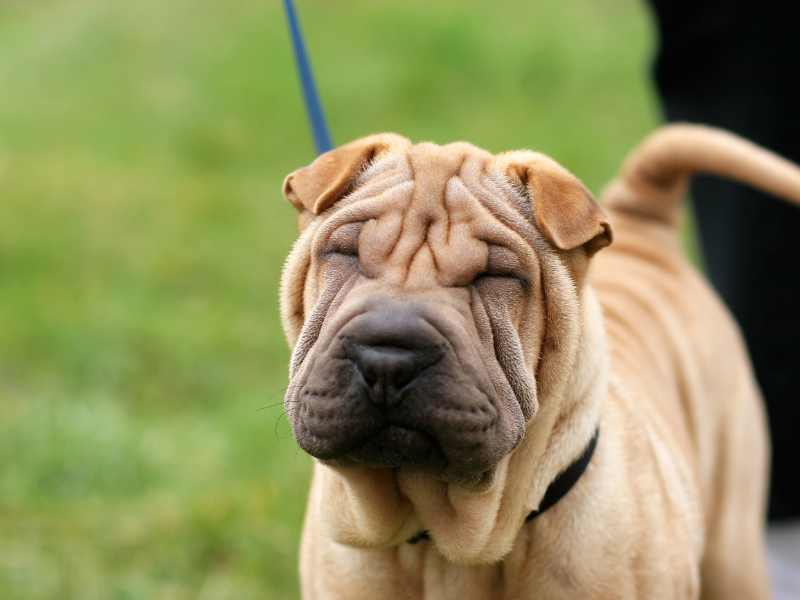Welcome to our exploration of the Box-a-Shar, a unique mix of Boxer and Shar-Pei. With crossbreeds gaining attention, the Box-a-Shar stands out. Combining Boxer’s liveliness with Shar-Pei’s distinct traits, they make a remarkable companion. Join us to uncover the crossbreed allure and the charm of the Box-a-Shar.

Understanding the Parent Breeds
To truly grasp the essence of the Shar-Pei Boxer mix, it’s imperative to delve into the traits, history, and temperament of its parent breeds—the Boxer and the Shar-Pei. This foundation enables us to appreciate the unique qualities that make up the intriguing blend of the Shar-Pei Boxer crossbreed.
The Boxer Breed

Traits and History: Hailing from Germany, Boxers are known for their muscular build, short coats, and distinct faces. Originally bred as versatile working dogs, they excelled in various roles, from hunting to guarding and companionship.
Temperament: Boxers embody a lively and playful disposition. Their loyalty, protectiveness, and affectionate nature contribute to their reputation as dedicated family members and vigilant guardians.
The Shar-Pei Breed

Origins and Attributes: The Shar-Pei has its roots in China, characterized by its wrinkled skin and unique “hippopotamus” face. Originally bred for guarding and hunting, this breed stands out for its distinct appearance.
Behavior and Personality: Shar-Peis often displays a calm and reserved demeanor. They are known to be loyal, independent, and protective, forming strong bonds with their families.
The Convergence of Traits
The Shar-Pei Boxer mix inherits an intriguing blend of the Boxer’s vivacity, loyalty, and playfulness, combined with the Shar-Pei’s calmness, independence, and protective nature. This fusion results in a companion that embodies the best attributes of both parent breeds—an engaging, loyal, and balanced companion.
Physical Appearance
The Box-a-Shar’s physical appearance is a captivating fusion of attributes inherited from both parent breeds—the Boxer and the Shar-Pei. As a mix of Boxer and Shar-Pei, the Box-a-Shar can inherit physical traits from both parent breeds. They may have a muscular build, a wrinkled face, and a short coat 1.
Size and Build
The Box-a-Shar typically exhibits a blend of the Boxer’s muscular and robust build with the Shar-Pei’s sturdiness. Box-a-Shars are large and strong dogs. They can weigh up to 65 pounds and stand 18-24 inches high at the shoulders 2.
Coat and Coat Variations
Coat Type: The Box-a-Shar’s coat can vary, often displaying a short and dense coat that mirrors the Boxer parent’s coat type.
Colors and Patterns: Their coat comes in a range of colors and patterns, influenced by both parent breeds. These can include brindle, fawn, black, cream, and more. Some Box-a-Shars may even showcase the Shar-Pei’s unique “horse coat” pattern, with a coarse texture and minimal shedding.
Distinctive Features
Head and Face: Their head can encompass a harmonious blend of the Boxer’s expressive eyes and the Shar-Pei’s distinctively wrinkled face. The muzzle may vary, capturing traits from both parent breeds.
Ears and Tail: Box-a-Shars can inherit semi-pricked or folded ears from the Shar-Pei parent, while their tail might exhibit a natural curl or a straighter appearance.
Individual Variation
It’s important to note that individual Box-a-Shars can display variations in their physical appearance, depending on the specific genetic combination inherited from their parent breeds.
An Intriguing Fusion
The Box-a-Shar’s physical attributes epitomize the captivating convergence of traits from both the Boxer and the Shar-Pei. Their size, build, coat variations, and distinctive features make them stand out as a unique and fascinating crossbreed—an embodiment of the best qualities inherited from their remarkable parent breeds.
Temperamental Blend
The Box-a-Shar’s temperament combines traits from its parent breeds, the lively Boxer and reserved Shar-Pei. This creates a unique companion with endearing and distinctive qualities. The temperament of a mixed-breed dog can vary, but the Box-a-Shar is often described as intelligent, loyal, calm, and affectionate3 4.
Merging Personality Traits
Playful and Loyal: The Boxer’s playful and affectionate nature merges with the Shar-Pei’s loyalty and independence, resulting in a companion that is both devoted and spirited.
Vigilant and Protective: The Shar-Pei’s natural protective instincts align with the Boxer’s alertness, making the Box-a-Shar an attentive guardian and a vigilant family member.
Role of Training and Socialization
Training: Proper training is essential to harness the best traits from both parent breeds. Consistent and positive training methods help channel their energy and intelligence into desirable behaviors.
Socialization: Early and comprehensive socialization ensures that the Box-a-Shar interacts confidently with people, other pets, and various situations. This reduces potential shyness or aggression.
A Well-Balanced Companion
By nurturing their inherent qualities through training and socialization, you’ll help your Box-a-Shar develop into a well-balanced and well-behaved companion. Their endearing blend of traits makes them adaptable to various living situations, from families with children to single individuals seeking a loyal friend.
Related: Boxer Shepherd: Traits, Care, and More
Energy and Exercise Needs
The Box-a-Shar’s energy levels and exercise requirements are influenced by the dynamic blend of its parent breeds—the lively Boxer and the relatively calm Shar-Pei. Understanding and fulfilling their physical and mental needs are essential for their overall well-being and happiness.
Energy Levels
The Box-a-Shar typically embodies a moderate energy level, striking a balance between the Boxer’s liveliness and the Shar-Pei’s more composed nature.
Exercise Requirements
Daily Activity: Providing regular exercise is crucial to keep your Box-a-Shar mentally stimulated and physically fit. Aim for at least 30 to 60 minutes of moderate exercise each day.
Variety: Engage them in a mix of activities to prevent boredom. This can include brisk walks, interactive play sessions, and puzzle toys.
Mental Stimulation: Incorporating mental challenges, such as training sessions, puzzle toys, and scent games, helps satisfy their need for mental engagement.
Social Interaction: Playdates with other dogs and visits to dog parks provide socialization opportunities that contribute to their mental well-being.
Activities for Mental Engagement
Training Games: Teach them new commands and tricks, which not only mentally engage them but also strengthen your bond.
Hide-and-Seek: Hide treats or toys around the house for them to find, tapping into their instincts.
Interactive Toys: Puzzle toys and treat-dispensing toys offer mental stimulation while they work to obtain rewards.
Potential Considerations
Be mindful of your Box-a-Shar’s age, health, and individual preferences. Adjust the intensity and duration of exercise based on their needs.
A Balanced Approach
Balancing physical activity and mental stimulation is key to a happy and content Box-a-Shar. Regular exercise not only keeps them in good physical shape but also contributes to their overall behavioral well-being, making them an even more delightful and well-rounded companion.
Grooming Routine
Maintaining your Box-a-Shar’s grooming needs is essential for their comfort and well-being. Their grooming requirements are influenced by their coat type, which is often a blend of the Boxer’s short coat and the Shar-Pei’s unique characteristics.
Coat Type and Care
Boxer Coat: The Box-a-Shar’s coat may reflect the Boxer parent’s short and dense coat, which generally requires minimal grooming.
Shar-Pei Influence: Some Box-a-Shars may inherit the Shar-Pei’s distinctive wrinkles and skin folds, particularly around the face and neck. These wrinkles require special attention to prevent moisture buildup and potential skin issues.
Grooming Tasks
Brushing: Regular brushing, at least once a week, helps distribute natural oils, prevent tangles, and remove loose fur. Use a soft-bristle brush for their short coat.
Wrinkle Care: If your Box-a-Shar has wrinkles, gently clean and dry them regularly to prevent irritation and infections. Use a damp cloth and ensure the skin is thoroughly dry.
Bathing: Bathe your Box-a-Shar as needed, typically every 6 to 8 weeks or when they become visibly dirty. Use a mild dog shampoo to maintain their coat’s natural oils.
Ear Cleaning: Regularly clean their ears to prevent wax buildup and infections. Use a dog ear cleaning solution and gently wipe the outer ear with a cotton ball.
Nail Trimming: Trim their nails every few weeks to prevent overgrowth and discomfort. Be cautious not to cut too close to the quick, which can cause bleeding.
Dental Care
Regular dental care is crucial for your Box-a-Shar’s overall health. Brush their teeth several times a week using a dog-specific toothbrush and toothpaste.
Professional Grooming
Consider occasional visits to a professional groomer, especially if your Box-a-Shar inherits the Shar-Pei’s wrinkles. Groomers can provide expertise in maintaining their unique coat and skin folds.
Tailored Care
Adjust the grooming routine based on your individual Box-a-Shar’s needs and coat characteristics. Regular grooming not only keeps them looking their best but also ensures their skin and coats remain healthy and comfortable.
Health Considerations
Understanding the potential health issues associated with the parent breeds—the Boxer and the Shar-Pei—is crucial for providing the best care for your Box-a-Shar. Regular vet visits and proactive preventive care are essential to ensure their well-being.
Common Health Issues
Boxer Health Concerns: Boxers can be prone to certain conditions, including heart issues like cardiomyopathy and hip dysplasia, a genetic disorder affecting the hip joint.
Shar-Pei Health Concerns: Shar-Peis may be susceptible to skin conditions due to their wrinkles, such as pyoderma. They can also develop entropion, a condition where the eyelids roll inward, leading to eye irritation.
Preventive Care
Regular Vet Visits: Schedule regular check-ups with your veterinarian, at least once a year, to monitor your Box-a-Shar’s overall health and catch any issues early.
Vaccinations: Stay up to date with vaccinations to protect your Box-a-Shar from common canine diseases.
Dental Health: Implement a dental care routine to prevent dental issues, which can affect their overall health.
Skin Care: If your Box-a-Shar inherits the Shar-Pei’s wrinkles, pay special attention to their skin folds to prevent infections and irritations.
Weight Management: Maintain a healthy weight to reduce the risk of joint issues and other health problems.
Spaying/Neutering: Consider spaying or neutering your Box-a-Shar, which can have positive effects on their health and behavior.
Early Detection
Regular vet visits and open communication with your veterinarian allow for early detection of potential health issues. Be attentive to any changes in behavior, appetite, or physical appearance.
A Lifetime of Care
Providing your Box-a-Shar with regular vet visits and proactive preventive care ensures they lead a healthy and happy life. By staying informed about common health concerns and taking proactive steps, you can be a responsible and caring owner, offering your Box-a-Shar the best chance at a long and vibrant life.
Related: Bullboxer Pit: Traits, Care, and More
Dietary Guidelines
Crafting a balanced and nourishing diet is essential to support your Box-a-Shar’s overall health and vitality. Their dietary needs are influenced by their unique blend of Boxer and Shar-Pei traits. Understanding their nutritional requirements, portion control, and potential sensitivities ensures their well-being.
Recommended Diet
High-Quality Dog Food: Opt for a high-quality commercial dog food that provides the necessary nutrients. Choose formulas that cater to their age, size, and activity level.
Protein-Rich: Protein is essential for muscle development and overall health. Look for a portion of dog food with a good balance of animal-based proteins.
Healthy Fats: Essential fatty acids support their skin, coat, and overall wellness. Look for sources like fish oil.
Complex Carbohydrates: Carbohydrates provide energy. Opt for whole grains like brown rice and sweet potatoes.
Fresh Fruits and Vegetables: Incorporate fruits and veggies for added vitamins, minerals, and antioxidants.
Portion Control
Weight Management: Monitor your Box-a-Shar’s weight to prevent obesity. Follow portion guidelines provided on the dog food packaging, adjusting based on their activity level and metabolism.
Feeding Schedule: Divide their daily food into two or three meals to prevent overeating and aid digestion.
Nutritional Needs
Puppy Stage: Growing Box-a-Shar puppies require more calories and nutrients. Choose a puppy-specific formula until they reach adulthood.
Adult Stage: Transition to an adult formula and adjust portion sizes accordingly.
Senior Stage: As they age, consider switching to a senior formula to address changing nutritional needs.
Dietary Sensitivities
Be aware of potential food allergies or sensitivities. If you notice symptoms like digestive issues, itching, or skin problems, consult your vet to explore possible dietary adjustments.
Hydration
Always provide fresh water to keep your Box-a-Shar hydrated.
Consult with Your Vet
Consult your veterinarian for personalized dietary recommendations tailored to your Box-a-Shar’s individual needs and health status.
Nourishment for Wellness
A balanced diet supports your Box-a-Shar’s overall health, energy levels, and longevity. By providing the right nutrients in the right amounts, you’re ensuring that your beloved companion thrives and enjoys a fulfilling life by your side.
Training and Socialization
Training and socialization play a pivotal role in shaping your Box-a-Shar’s behavior and ensuring they become a well-mannered and confident companion. Understanding their intelligence and independent nature can guide you in implementing effective training strategies.
Training Strategies
Positive Reinforcement: Use positive reinforcement techniques like treats, praise, and toys to reward desired behaviors. This approach encourages your Box-a-Shar to repeat behaviors you appreciate.
Consistency: Be consistent in your commands and expectations. This helps your dog understand what is expected of them.
Short Sessions: Keep training sessions short and engaging to maintain their focus. Aim for sessions lasting around 10-15 minutes.
Mental Stimulation: Incorporate mental challenges like puzzle toys and interactive games to prevent boredom.
Intelligence: Recognize their intelligence and adapt training methods to keep them mentally stimulated.
Socialization Importance
Early Exposure: Introduce your Box-a-Shar to various people, places, sounds, and situations during their critical socialization period (between 3 and 14 weeks old).
Confidence Building: Proper socialization builds their confidence, making them less likely to be anxious or fearful in new environments.
Dog Etiquette: Exposing them to other dogs helps them learn proper social cues and how to interact with different canine personalities.
Obedience Training: Teaching basic commands like “sit,” “stay,” and “come” enhances their safety and strengthens the bond between you.
Independence and Recall
Independence: Understand that the Shar-Pei’s independent nature may lead to some stubbornness during training. Patiently work through challenges.
Recall Training: Teaching a reliable recall (coming when called) is crucial due to their potential independent streak.
Professional Training
Enrolling your Box-a-Shar in obedience classes or working with a professional trainer can provide guidance and help address any training difficulties.
Lifelong Learning
Training and socialization are ongoing processes. Continue engaging your Box-a-Shar in new experiences throughout their life to keep their skills sharp and their confidence high. With patience, consistency, and positive reinforcement, you can mold your Box-a-Shar into a well-behaved and socially adept companion.
Related: Boxer Basset Mix: Traits, Care, and More
Living Arrangements and Compatibility
Creating an environment that suits your Box-a-Shar’s needs and ensuring harmonious interactions with family members, children, and other pets are key factors in their well-being and happiness.
Suitable Living Environments
Indoor Living: Box-a-Shars thrive in indoor environments where they can be close to their human family. Their short coat may make them sensitive to extreme weather conditions.
Space: While adaptable, having ample indoor space for them to move around comfortably is beneficial.
Outdoor Time: Outdoor playtime and walks are important, but they should primarily be indoors to be near their family.
Interaction with Family
Social Creatures: Box-a-Shars are social dogs that enjoy being part of family activities.
Children: They often get along well with children when properly socialized. Teach children how to interact respectfully with dogs and supervise interactions.
Other Pets: Early socialization and gradual introductions are key to successful interactions with other pets. Monitor their interactions closely initially.
Companionship Needs
Box-a-Shars thrive on companionship and may experience separation anxiety if left alone for extended periods. Consider your schedule and ensure they have companionship through family members or other pets.
Exercise and Play
Provide daily exercise and mental stimulation to prevent boredom and promote their well-being.
Adapting to Urban or Rural Settings
Box-a-Shars can adapt to both urban and rural environments. Urban areas require consistent leash walks, while rural settings offer more space for them to explore.
Safety and Security
Create a safe environment with secure fencing and pet-proofing measures. Their independent nature might make them curious explorers.
Your Box-a-Shar’s Happiness
Creating a living environment that aligns with your Box-a-Shar’s needs and compatibility with your family dynamics ensures their contentment and allows them to thrive as a cherished member of your household.
Summary
The Box-a-Shar crossbreed, a fusion of Boxer and Shar-Pei breeds, embodies a captivating combination of distinct traits. This blog delves into their origins, physical attributes, temperamental characteristics, and care essentials, spotlighting the exceptional nature of the Box-a-Shar as a companion. This summary provides a comprehensive overview of the main points discussed in the subsequent sections.
Understanding the dual parent breeds helps unravel Box-a-Shar’s temperament—a balance between Boxer’s energy and friendliness and Shar-Pei’s loyalty and independence. From their physical appearance to grooming routines, health considerations, and living compatibility, we explore the comprehensive care required to nurture a thriving Box-a-Shar companion.
Frequently Asked Questions (FAQs)
Yes, Box-a-Shars can be wonderful family pets. They often possess a mix of loyalty and protective instincts, but proper socialization and training are essential for a harmonious family environment.
Box-a-Shars are energetic dogs and need around 1 to 2 hours of exercise per day. Engaging in activities like play, walks, and mental challenges will help maintain their well-being.
Common health concerns can include hip dysplasia, certain heart conditions, and potential breed-specific issues from both Boxers and Shar-Peis. Regular veterinary care, a balanced diet, and proactive health management are important.
Absolutely, many shelters and rescues might have Box-a-Shars or similar mixed breeds available for adoption. Adopting from a shelter is a compassionate way to provide a loving home to a dog in need.
Effective training involves positive reinforcement and consistency. Utilize their intelligence and adaptability, tailoring training methods to their unique qualities. Early socialization and ongoing training are key for a well-mannered and balanced companion.
Citations
1 Box-a-Shar Dog Breed Information and Pictures
2 Box-A-Shar (Boxer & Shar Pei Mix): Info, Pictures …
